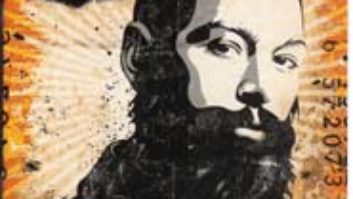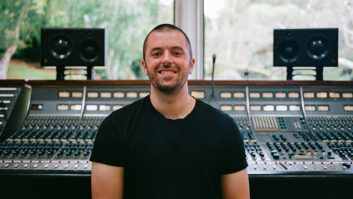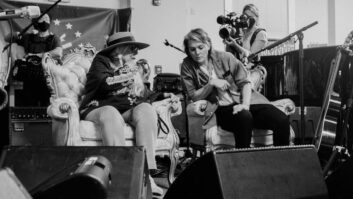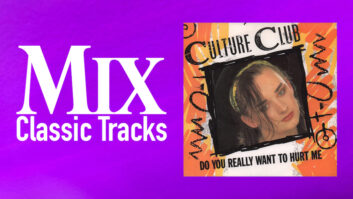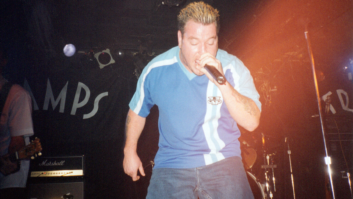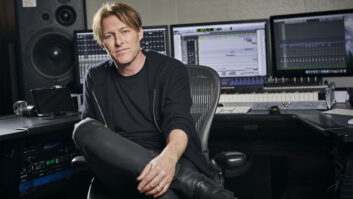Call it the “Grateful Dead Syndrome”: a problem that seems to afflict nearly every group that’s part of the current jam band scene is that their studio albums fail to duplicate the energy, intensity and improvisational glory of their live performances. From the bands’ perspective, they want to put out albums that show off their new material in a positive light and demonstrate, to both the uninitiated and the faithful, that they’re about songs — not just jamming — and perhaps garner some radio airplay in the process, because there are few stations that will play a 12-minute live track, no matter how hot the guitar solos. Traditionally, jam bands have had trouble breaking out of their niche to gain wider acceptance: Groups such as String Cheese Incident, Widespread Panic and even the reigning kings of the genre, Phish, remain largely live phenomena, earning most of their scratch on the road rather than from CD sales.
The upstate New York band moe. is a little further down jam band’s popularity ladder than the groups mentioned above, but they’ve still managed to developed a large, rabid following, particularly up and down the East Coast, over the course of the past decade-plus. And for my money, they’re the most compelling band in the genre. Always unpredictable, fabulously eclectic and unfailingly adventurous, moe. is extremely difficult to characterize: One song might sound like the bastard offspring of a Neil Young song and a Led Zeppelin tune; another might start with skittering Afro-pop guitars, move into a reggae groove and close out with a guitar crescendo that sounds like hopped-up Lynyrd Skynyrd. Complicated passages worthy of Frank Zappa or King Crimson sit side by side with punk-flavored rave-ups and deeply psychedelic voyages somewhat in the Dead tradition. The group boasts two exceptional guitarists — Al Schnier and Chuck Garvey — who are capable of both flashy pyrotechnics and spacey delicacy, and a rhythm section — bassist Rob Derhak, drummer Vinnie Amico and percussionist Jim Loughlin — that can turn on a dime and play convincingly in any genre. Schnier and Derhak are the primary singers and songwriters who have shown impressive development through the years.
Their album output has been somewhat uneven; like most of their fans, I’ve preferred their live outings, such as L and especially the first two volumes of their Warts and All Series (released on their own Fatboy label), to their studio product. However, for their new iMusic/ARTISTdirect CD — titled Wormwood, after one of the principal ingredients in the potent intoxicant absinthe — moe. decided to try a new approach to recording a “studio” album: cutting basic tracks live on the road and then overdubbing in a conventional studio. The result is an album that has a lot of the magic of moe.’s incendiary performances and the sonics of a traditional studio effort.
We spoke with guitarist Schnier twice during the process of cutting Wormwood: first in early June 2002, when the band began recording, and again in October, when the album was completed and mastered — sort of a “before and after” view of the album-making process.
JUNE 2002: DREAMS AND INTENTIONS
“The new moe. album has officially begun!” Schnier enthuses from a hotel room in Cincinnati the morning after a gig. “Here’s the plan: We have about 15 new songs that are slated for the next album, and rather than going into the studio and trying to re-create the live vibe that every group goes for when they’re doing the basics, we figured that we would record all of this stuff on the road — during soundchecks, backstage, in hotel rooms, etc. — and use those for our basics in the studio. Then, we’ll add all of the bells and whistles and studio magic in a regular studio.
“So with that in mind, we purchased two of the Tascam MX-2424s and we have those set up in a rack, along with a G4 and some Glyph hard drives. Our monitor engineer, Bil Emmons, is an excellent studio engineer who we’ve worked with in the past and are fortunate enough to have on the road with us now. So he’s running monitors and tape machines simultaneously, and then once we get into the studio, he’ll be the head engineer. With the hard drive space we have and the way we have it all configured — I think we’re about 40 tracks — we can record about three-and-a-half hours with our current setup.
“We did a fair amount of pre-production on the songs before the tour, just to make sure that we had good arrangements down and the songs were exactly where we wanted them. However, we left the solo sections sort of open, and the transitions between songs are a whole other can of worms we’re faced with. A lot of times, we segue from one song into the next: We can play for an hour straight without stopping to say, ‘Thank you,’ or, ‘Are you still paying attention?’ So our bass player, Rob Derhak, suggested where we would come up with several ideal album sequences and actually play the album in its entirety, with segues and everything, from one song into the next over a block of about 60 minutes. Ideally, we’ll have three or four different versions of what the album sequence will be, and we can go out and try that and cast the entire framework for the album in one night. It’s definitely a bit adventurous, and I don’t know if it’s likely that we’ll capture the entire album in one performance; but then again, you never know — or maybe we could do it over a couple of nights. The idea is to put out an album that sounds like a collective body of work and not just 10 independent songs that happen to be on the same CD.”
As a concession to the live recording, Schnier says, “We’ve tried to rein in the sound a bit to create a little more isolation onstage. We actually put up a Plexiglas gobo around the drum kit. Last night was the first night we tried it and it fell over; I don’t know if that’s gonna last. We went to [Shure] 57s on our vocal mics to cut down on the bleed. We got to demo the Neumann KM184 prototypes, which sounded awesome, but I believe those went out to Sting. We’d also used the Shure Beta 58 mics, but I really liked the sound of the old-school 57s. We’ve since reconnected with Neumann and now use the KM184s exclusively. We’re doing a lot of close-miking, of course. We also have a pair of [AKG] 414s on either side of the stage, and our front-of-house engineer, Steve Young, does a matrix mix [combining the stage mics and the 414s]. Essentially, we have three different mixes going: Steve’s FOH mix, the mix for the recording through the monitor console and then our regular in-ear monitor mix, which has nothing to do with what’s going to tape or what’s going to FOH.”
After the live recording part of the process was complete, Bill Emmons was to do some digital editing to get the tracks in shape for the overdub process, scheduled for a two-week block at Long View Farm Recording Studios in beautiful, rural North Brookfield, Mass. “They’ve got a wonderful Trident A Range console there [the studio’s Farmhouse room] and all of the outboard equipment we’ll need,” explains Schnier. “Ideally, if we were some famously wealthy band, we would have had a rack of 40 preamps on the road with us for the recording, but we don’t have that. It’ll still sound really good; I’m not worried about that.” Indeed, at Long View, the band could avail itself of a wide assortment of high-quality outboard gear by API, Neve, John Hardy, Focusrite, Avalon, dbx, Lexicon, Yamaha and more.
“If everything goes according to plan,” Schnier says, “it will be a relatively straightforward process and hopefully something we’ll be able to repeat on future albums.”
OCTOBER 2002: A DOSE OF REALITY
“We’re done with the album!” Schnier exults the day after moe. appeared at the Jammy Awards, where the group won the Live Performance of the Year trophy for their performance at the huge Bonnaroo Music Festival in rural Tennessee last June. “It’s been mastered, and we’ve already made another album, actually.”
Say what? “We went out on the road opening for Robert Plant, and then the last part of the tour was on our own, and Rob [Derhak] challenged us to try to make a holiday album by the time we got home. So we recorded 10 holiday songs — Christmas songs, Hanukkah songs, a couple of originals, some of ’em done sort of old-school punk, others more straightforward — using the same setup we used for our regular album. We recorded during soundcheck every day; at the end, we went into Water Music in Hoboken [N.J.] and we had two-and-a-half days to do all of our overdubs, which was insane, of course. We were totally burning the midnight oil.” The disc, called Season’s Greetings From moe., came out in November.
Okay, that’s cool. But how did it go with Wormwood?
“Well, of course it ended up being a lot harder and more complicated than we’d expected,” Schnier says with a laugh. “What happened was, we got to the studio and we’d chosen our best versions of the songs. But what we didn’t realize was the tremendous amount of computer work that lay in front of us: isolating the songs we needed and then creating files that were like the finished, edited versions that would become the basic tracks. The plan was that while we were on the road, we would send files home to Mitch Getz, who was the guy who built the rack and wired and configured everything for us, and he’d convert the files for us. By the time we got to the studio, we’d be ready to start doing our overdubs. There were a couple of problems. First of all, we were playing up to the day before we went into the studio; in fact, that show was also considered for this album. But the main problem was that we just had tons of music to listen to. We were giving Mitch a two-hour chunk of music and saying, ‘All right, we want this song or these three songs from this night,’ and it takes a while to sift through that and isolate the specific 10 minutes of music we want.
“When we got into the studio, I spent the first five or six days working about 16 hours a day in front of a computer and we didn’t do any recording at all. We could’ve stayed home or been in a hotel room doing the kind of stuff we were doing — it was very frustrating. Then our engineer came down with walking pneumonia, but fortunately, Mitch came up a couple of times to bail us out and help on engineering until Bill got back on his feet. But somehow, miraculously, we got through it. Eventually, we got it all up and running, and then in about a week-and-a-half, we ended up doing all of our overdubs and everything; everyone totally rose to the occasion. But it was definitely the most intense recording experience I’ve been involved in.”
One disadvantage of using the live tracks for the basics was, “we found that the drum sounds were a little different every night, even though we were using the same mics, the same console. But the rooms were different, and some of them weren’t even rooms — we’d be outside playing on a stage in a field, or something.” When the album was mixed at Water Music, “to get a nice full sound from the drums, Bill got a huge P.A. and stuck it into the studio’s kickin’ live room and we sent the drum tracks [to tape] that way. It really added a lot of girth to the kick drum and gave us some nice room sounds,” Schnier notes.
“Much harder was the process of dealing with all of the edits — taking an eight-minute guitar solo and turning it into something a little more reasonable for the studio album and having that sound natural. I think we managed to pull that off. There are also moments on the album when you can hear a little crowd noise. It wasn’t something we intended, but there they are. It still sounds like a studio album, but now and then you’ll hear a fan screaming in the distance; it’s an interesting effect.”
The other part of the equation that didn’t quite work out as planned was the notion of preplanning all of the segues between songs and recording those live, as well. It is still one continuous piece of music, “but only some of them were things we improvised live onstage and added more things to; some of them ended up being completely manufactured in the studio, which wasn’t easy.”
A grand and noble recording experiment, to be sure, and, as the band hoped, Wormwood is a fine showcase for the group’s latest songs. The live energy did translate, yet it sounds, unmistakably, like a studio album. Though in June Schnier talked about overdubbing strings and horns and other exotica, for the most part, the overdubs are dominated by various retro analog-synth sounds — sort of an early ’70s Pink Floyd touch that’s surprisingly effective.
Since the CD was completed, moe. has learned a lesson. As Schnier puts it, “We really don’t know when or how the next studio album will be done. But, we’ve got a good working [recording] system now, and if we planned to use the same method, we’d take the time to go home and edit the tracks before we went into the studio.”
